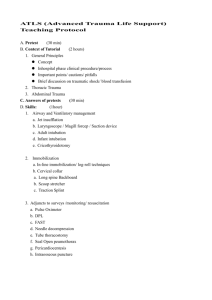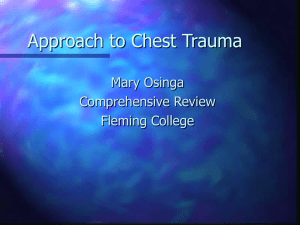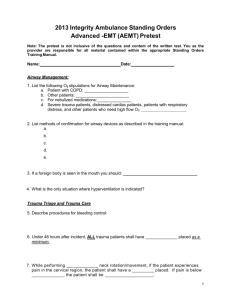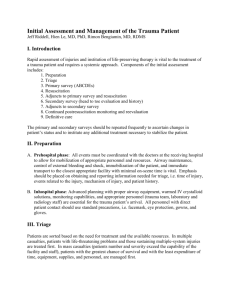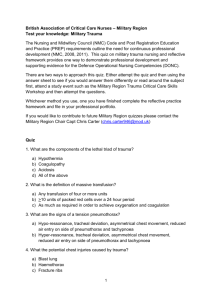Avanced Trauma Life Support
advertisement
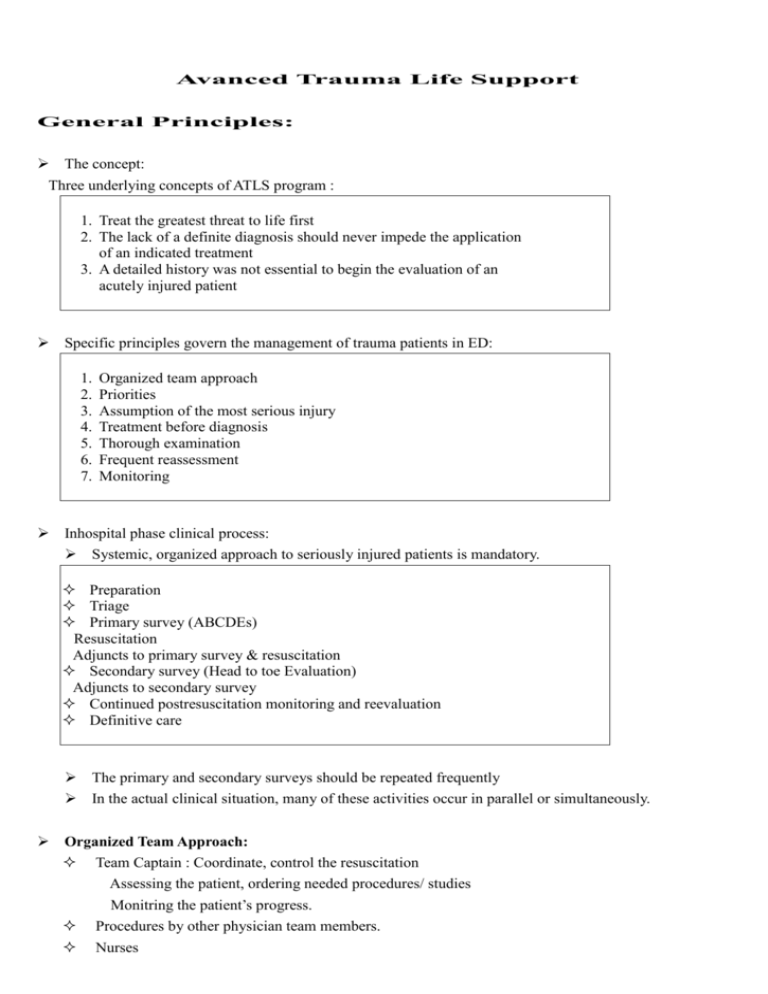
Avanced Trauma Life Support General Principles: The concept: Three underlying concepts of ATLS program : 1. Treat the greatest threat to life first 2. The lack of a definite diagnosis should never impede the application of an indicated treatment 3. A detailed history was not essential to begin the evaluation of an acutely injured patient Specific principles govern the management of trauma patients in ED: 1. 2. 3. 4. 5. 6. 7. Organized team approach Priorities Assumption of the most serious injury Treatment before diagnosis Thorough examination Frequent reassessment Monitoring Inhospital phase clinical process: Systemic, organized approach to seriously injured patients is mandatory. Preparation Triage Primary survey (ABCDEs) Resuscitation Adjuncts to primary survey & resuscitation Secondary survey (Head to toe Evaluation) Adjuncts to secondary survey Continued postresuscitation monitoring and reevaluation Definitive care The primary and secondary surveys should be repeated frequently In the actual clinical situation, many of these activities occur in parallel or simultaneously. Organized Team Approach: Team Captain : Coordinate, control the resuscitation Assessing the patient, ordering needed procedures/ studies Monitring the patient’s progress. Procedures by other physician team members. Nurses Priorities In Management and Resuscitation Immediate / potential threats to life 1. High-priority areas Airway/ breathing Shock/ external hemorrhage Impending cerebral hemorrhage Cervical spine 2. Low-priority areas Neurologic Abdominal Cardiac Musculoskeletal Soft tissue injury Assumption of the Most Serious Injury Assume the worst possible injury Mechanism of injury Treatment Before Diagnosis Based on initial brief assessment The more unstable the patient, the less necessary to confirm alife-threatening diagnosis before it is expeditiously treated Thorough Examination When time and the patient’s stability permit. Unconscious/ alcohol intoxicated patients Frequent Reassessment Dynamic process Some injuries take time to manifest Any sudden worsening in the physiologic status of the patients mandates a return to the “ABCDEs” Monitoring Vital signs Pulse oximetry I/O Lab: ABG, Ht CVP Inhospital Phase ATLS PREPARATION Resuscitation area Proper airway equipment Warmed IV crystalline solutions Monitoring capabilities Summon extra medical assistance Prompt response by lab and radiology personnel Transfer route Periodic review Standard precautions TRIAGE Based on the ABCDE priority PRIMARY SURVEY Airway with Cervical spine protection Breathing and ventilation Circulation with hemorrhage control Disability: Neurologic status Exposure/ Environmental control Airway Maintenance with Cervical Spine Protection Q : What are the problems that lead to airway compromise ? Q : What are the indications for definite airway ? Indications For Definite Airway Need for Airway Protection Need for Ventilation Unconscious Apnea GCS ≤ 8 Neuromuscular paralysis Unconscious Severe maxillofacial fractures Inadequate respiratory effort Tachypnea Hypoxia Hypercarbia Cyanosis Risk for aspiration Severe closed head injury with Bleeding need for hyperventilation Vomiting Risk for obstruction Assessment: Ascertain patency Rapidly assess for airway obstruction Foreign bodies, facial / mandibular / tacheal / larygeal fractures. Management: Chin lift / jaw thrust maneuver Clear the airway of FB Insert an orotracheal / nasopharyngeal airway Establish a definitive airway 1. Orotracheal / nasotracheal intubation 2. Surgical cricothyroidotomy Jet insufflation Maintain the cervical spine in a neutral position with manual immobilization as necessary when establishing an airway Immobilization of the c-spine with appropriate devices after establishing an airway. Important Notes: NE does not exclude a cervical spine injury Assume a cervical spine injury in any patient with multisystem trauma, especially with an altered level of consciousness or a blunt injury above the clavicle Pitfalls: Equipment failure Cannot be intubated after paralysis and accompanied with difficult surgical airway Unknown laryngeal fracture / incomplete airway transection. Breathing and Ventilation Q : What are the injuries that may acutely impair ventilation in the primary survey? Injuries that should be identified in the Primary survey : 1. Tension pneumothorax 2. Flail chest with pulmonary contussion 3. Massive hemothorax 4. Open pneumothorax Assessment : Inspection / palpation /Auscultation / Percussion Expose the neck and chest Respiratory rate and depth Inspect and palpate: tracheal deviation ? symmetrical chest movement ? use of accessory muscles ? signs of injury ? subcutaneous emphysema ? Cyanosis ? Auscultate the chest Percussion : dullness? hyperresonance? Management : Administer high concentrations of oxygen Ventilate with BVM Alleviate tension pneumothorax : needle decompression / Place chest tube Indication for thoracotomy Seal an open pneumothorax Pulse oximeter Important Notes : Always check for one-lung intubation, chest X-rays should be performed Pitfalls : If the ventilation problem is produced by a pneumothrax, intubation with MV could lead to deterioration. The procedure itself may produce a pneumothorax Circulation with Hemorrhage Control Q : What are the elements that provide the information about the hemodynamic status of the injured patients. These elements are: 1. Level of consciousness 2. Skin color 3. Pulse ( quality, rate, regularity ) Presence of a carotid pulse SBP 60 mmHg femoral pulse SBP 70 mmHg radial puse SBP 80 mmHg External bleeding is identified and controlled in the primary survey. Operative intervention for internal bleeding control. Q : What are the injuries that may acutely impair circulation status ? These injuries are : 1. External/internal bleeding with hypovolemic shock 2. Massive hemothorax 3. Cardiac tamponade Assessment: Identify source of external hemorrhage Identify potential source(s) of internal hemorrhage / Pulse / skin color, capillary refill / Blood pressure Management: Apply direct pressure to external bleeding site. Internal hemorrhage ? Need for surgical intervention ? Establish IV access / central line / IO Fluid resuscitation / blood replacement Important Notes : Hypotension following injury must be considered to be hypovolemic in origin until proved otherwise. Pitfalls : The elderly, children, athletes and others with chronic medical conditions do not respond to volume loss in similar manner Disability Assessment : Level of consciousness in the AVPU scale Alert Voice illicits response Pain illicits response Unresponsive GCS Pupils size, equality and reaction Management : Intubation and allow mild hyperventilation Administer IV mannitol ( 1.5-2.0g/kg ) Arrange for brain CT Important notes : CT is contraindicated when the patient is hemodynamically unstable A decrease in the level of consciousness may due to: a. Decreased cerebral oxygenation (A,B) b. Decreased cerebral perfusion (C) c. Direct cerebral injury (D) d. Alcohol / drugs Always rule out hypoxemia and hypovolemia first. Reevaluation Pitfalls : Lucid interval of acute EDH, reevaluation is important. Exposure / Environment Control Completely undressed the patient. Prevent hypothermia Injured patients may arrive in hypothermic condition Log-roll RESUSCITATION To reverse immediately life-threatening situations and maximize patient survival NECCESSARY PROCEDURE TREATMENT PRIORITY Airway Breathing/Ventilation/oxygenation Circulation/hemorrhage control 1. Jaw thrust/chin lift/ 2. Suction 3. Intubation 4. Cricothyroidotomy ( with protection of C-spine ) 1. Chest needle decompression 2. Tube thoracostomy 3. Supplemental oxygen 4. Seal open pneumothorax 1. IV line/ central line 2. Venous cutdown 3. Fluid resuscitation/Blood transfusion 4. Thorocostomy for massive hemothorax 5. Pericardiocentesis for cardiac tamponade Disability Exposure/Environment 1. Burr holes for trans-tentorial herniation 2. IV mannitol 1. Warmed crystalloid fluid 2. Temperature ADJUNCTS TO PRIMARY SURVEY AND RESUSCITATION Electrocardiographic Monitoring. Urinary Catheter Gastric Catheter Monitoring ABG Pulse oximeter Blood pressure X-rays AP CXR AP pelvis C-spine Diagnostic peritoneal lavage Abdominal ultrasonography (FAST) CONSIDER NEED FOR PATIENT TRANSFER SECONDARY SURVEY The secondary survey does not begin until: the primary survey is completed, resuscitation efforts are well established, the patient is demonstrating normalization of vital functions. Head-to-toe evaluation Complete history and PE Reassessment of all vital signs. Complete NE. Indicated x-rays are obtained. Special procedures Tubes and fingers in every orifice History: AMPLE history Allergies Medications currently used Past illness/ Pregnancy Last meal Events/ Environment related to the injury Mechanism/blunt/penetrating/burns/cold/hazardous environment Physical Examination: Table 1. Pitfalls: Facial edema in patients with massive facial injury or patients in coma can preclude a complete eye examination. Blunt injury to the neck may produce injuries in which clinical signs and symptoms develop late.(e.g. Injury to the intima of the carotid a.) The identification of cervical n. root/brachial plexus injury may not be possible in the comatose patient. Decubitus ulcer from immobilization on a rigid spine board/cervical collar. Children often sustain significant injury to the intrathoracic structures without evidence of thoracic skeletal trauma. A normal initial examination of the abdomen does not exclude a significant intraabdominal injury. Patients with impaired sensorium secondary to alcohol/drugs are at risk. Injury to the retroperitoneal organs may be difficult to identify. Female urethral injury are difficult to detect. Blood loss from pelvic fractures can be difficult to control and fatal hemorrhage may result. Fractures involving the bones of extremities are often not diagnosed. Most of the diagnostic and therapeutic maneuvers increase ICP. ADJUNCTS TO THE SECONDARY SURVEY These specialized tests should not be performed until the patient’s hemodynamic status has been normalized and the patient has been carefully examined. Additional x-rays of the spine and extremities CT of the head, chest, abdomen, and spine Contrast urography Angiography Bronchoscopy Esophagoscopy Others REEVALUATION The trauma patient must be reevaluated constantly to assure that new findings are not overlooked. A high index of suspicion Continuous monitoring of vital signs and urinary output is essential. ABG/cardiac monitoring/ pulse oximetry Pain relive- IV opiates/anxiolytics. DEFINITIVE CARE Transfer to a trauma center or closest appropriate hospital. TRAUMATIC SHOCK Recognition of Shock : Early: Tachycardia and cutaneous vasoconstriction Normal heart rate varies with age, tachycardia is present when Infant: >160 BPM Preschool age child: >140 BPM School age to puberty: >120 BPM Adult: >100 BPM The elderly patient may not exhibit tachycardia because of the limited cardiac response to catecholamine stimulation / use of medications Differentiation of shock: Hemorrhagic shock hypovolemic shock Nonhemorrhagic shock: a. Cardiogenic shock: Blunt cardiac injury, cardiac tamponade, air embolus, myocardial infarction. b. Tension pneumothorax c. Neurogenic shock d. Septic shock The normal blood volume of adult is 7 % of body weight. Whereas that of a child is 8-9% of body weight. Estimated Fluid and Blood Losses: ( For a 70-kg man ) Class I Class II Class III Up to 750 750-1500 1500-2000 Blood Loss (ml) Up to 15 % 15-30 % 30-40 % Blood Loss (% Blood Volume) <100 >100 >120 Pulse Rate Normal Normal Decreased Blood Pressure Normal or Decreased Decreased Pulse Pressure increased (mmHg) 14-20 20-30 30-40 Respiratory Rate >30 20-30 5-15 Urine Output (mL/hr) Slightly Mildly Anxious, CNS/Mental status anxious anxious Confused Crystalloid Crystalloid Crystalloid Fluid Repacement and blood (3:1 rule) Fluid Therapy: Fluid bolus: 1-2 liters for an adult and 20mL/kg for a pediatric patient 3:1 rule 39 C ( 1 liter fluid, microwave, high power, 2 minutes ) Class IV >2000 >40 % >140 Decreased Decreased > 35 Negligible Confused, lethargy Crystalloid and blood Blood Replacement: PRBC/Whole blood Crossmatched/type-specific/ type O blood FFP ( 1U FFP for every 5 U PRBC) CVP monitoring Thoracic Trauma PATHOPHYSIOLOGY 1. Hypoxia: a. Hypovolemia (blood loss); b. Pulmonary ventilation / perfusion mismatch (contusion, hematoma, alveolar collapse); c. Changes in intrathoracic pressure relationships (tension pneumothorax, open pneumothorax) 2. Hypercarbia: a. Inadequate ventilation due to changes in intrathoracic pressure; b. Depressed level of consciousness 3. Metabolic acidosis: Hypoperfusion of the tissues (shock) ASSESSMENT & MANAGEMENT: Must consist of: 1. Primary survey 2. Resuscitation of vital functions 3. Detailed secondary survey 4. Definitive care PRIMARY SURVEY ( Life-threatening injuries ) Airway: Recognition of: Stridor, change of voice quality, obvious trauma Major problems: 1. FB obstructions, 2. Laryngeal injury, 3. Posterior dislocation / fracture dislocation of the sternoclavicular joint. Management: Establishing a patent airway/ ET intubation; closed reduction. Breathing: Recognition of: Neck vein distention, respiratory effort and quality changes, cyanosis Major problems: 1. Tension pneumothorax: Clinical diagnosis Chest pain, air hunger, respiratory distress, tachycardia, hypotension, tracheal deviation, unilateral absence of breath sounds, neck vein distention, cyanosis. (V.S. cardiac tamponade) Hyperresonant percussion. Immediate decompression: Needle decompression/ chest tube. 2. Open pneumothorax: 3. 2/3 of the diameter of the trachea – impaired effective ventilation Sterile occlusive dressing, taped securely on 3 sides. Chest tube (remote) Flail chest: 4. 2 ribs fractured in two or more places. Severe disruption of normal chest wall movement. Paradoxical movement of the chest wall. Crepitus of ribs. The major difficulty is underlying lung injury ( pulmonary contusion) Pain. Adequate ventilation, humidified oxygen, fluid resuscitation. The injured lung is sensitive to both underresuscitation of shock and fluid overload. Massive hemothorax: Compromise respiratory efforts by compression, prevent adequate ventilation. Circulation: Assessment: Pulse quality, rate and regularity. BP, pulse pressure, observing and palpating the skin for color and temperature. Neck veins. Important notes: Neck veins may not be distented in the hypovolemic patient with cardiac tamponade, tension pneumothorax,or traumatic diaphragmatic injury. Monitor with: Cardiac monitor/pulse oximeter. Major problems: 1. Massive hemothorax: Rapid accumulation of > 1500 mL o blood in the chest cavity. Hypoxia Neck veins may be flat secondary to hypovolemia Absence of breath sounds and/or dullness to percussion on one side of the chest Management: Restoration of blood volume and decompression of the chest cavity. Indication of thoracotomy: a. Immediately 1500 mLof blood evacuated. b. 200mL/hr for 2-4 hrs. c. Patient’s physiology status. d. Persistent blood transfusion requirements. 2. Cardiac tamponade: Beck’s triad: venous pressure elevation, decline in arterial pressure, muffled heart tones. Pulsus paradoxicus. Kussmaul’s sign. PEA Echocardiogram. Management: Pericardiocentesis. RESUSCITATIVE THORACOTOMY Left anterior thoracotomy The therapeutic maneuvers that can be effectively accomplished with a resuscitative thoracotomy are: Evacuation of pericardial blood causing tamponade. Direct control of exsanguinating intrathoracic hemorrhage Open cardiac massage Cross cramping of the descending aorta to slow blood loss below the diaphragm and increase perfusion to the brain and heart. SECONDARY SURVEY: Further in-depth PE, Chest x-rays (PA), ABG, Monitoring. Eight lethal injuries are considered: 1. Simple pneumothorax 2. Hemothorax 3. Pulmonary contusion 4. Tracheobronchial three injuries 5. Blunt cardiac injuries 6. Traumatic aortic disruption 7. Traumatic diaphragmatic injury 8. Mediastinal traversing wounds. Simple Pneumothorax Breath sounds are decreased on the affected side. Percussion demonstrates hyperresonance. CXR Chest tube insertion F/U CXR.. Never use general anesthesia or positive pressure ventilation to patient who sustains traumatic pneumothorax until a chest tube is inserted. Hemothorax Lung laceration/ intercostal vessel laceration/ Int.mammary a. Laceration. Chest tube Guide line of surgical exploration. Pulmonary Contusion Respiratory failure. Patients with significant hypoxia should be intubated. Monitoring. Tracheobronchial Tree Injury Hemoptysis, subcutaneous emphysema, tension pneumothorax with a mediastinal shift. Pneumothorax associated with a persistent large air leak after tube thoracostomy. Bronchoscopy Opposite main stem bronchial intubation. Intubation may be difficult operative intervention Blunt Cardiac Injury Result in: Myocardial muscle contusion, cardiac chamber rupture, valvular disruption. Hypotension, ECG abnormalities, wall-motion abnormality ECG: VPC, sinus tachycardia, Af, RBBB, ST seg. changes. Elevated CVP. Monitor. Traumatic Aortic Disruption High index of suspicion Adjunctive radiological signs: Widened mediastinum Obliteration of the aortic knob Deviation of the trachea to the right Obliteration of the space between the pulmonary artery and the aorta Depression of the left main bronchus Deviation of the esophagus to the right Widened paratracheal stripe Widened paraspinal interfaces Presence of a pleural or apical cap Left hemothorax Fractures of the first or second rib or scapula. Angiography is the gold standard. On critical. Traumatic Diaphragmatic Injury More commonly diagnosed on the left side NG tube UGI series. Direct repair. Mediastinal Traversing Wounds Surgical consultation is mandatory. Hemodynamic abnormal : thoracic hemorrhage, tension pneumothorax, pericardial tamponade. Mediastinal emphysema: esophageal or tracheobronchial injury. Mediastinal hematoma: great vessel injury. Spinal cord. For stable patient. Angiography Water-soluble contrast esophagography Bronchoscopy CT Ultrasonography. Others Subcutaneous emphysema Traumatic Asphyxia Compression of the SVC. Upper torso, facial and arm plethora. Rib, Sternum, and Scapular fractures. Blunt esophageal Rupture Abdominal Trauma Mechanism of Injury: Blunt Trauma: Spleen, liver, retroperitoneal hematoma Penetrating Trauma: Stab: Liver, small bowel, diaphragm, colon Gunshot: small bowel, colon, liver, abdominal vascular structures. Assessment: Hitory. PE: Inspection Auscultation: 1. Bowel sounds Percussion 1. signs of peritonitis 2. Tympanic/ diffuse dullness Palpation 1. Involuntary muscle guarding Evaluation of penetrating wounds: Determine the depth Assessing pelvic stability: Manual compression Penile, perineal and rectal examination: 1. Presence of urethral tear. 2. Rectal exam: Blunt (sphincter tone, position of the prostate, pelvic bone fractures), Penetration (sphincter tone, gross blood from a perforation) Vaginal examination Gluteal examination Intubation: Gastric tube: Relieve acute gastric dilatation. Presence of blood Urinary catheter: Relieve urine retention Monitoring urine output. Caution: The inability to void, unstable pelvic fracture,blood in the meatus, a scrotal hematoma, perineal ecchymoses, high-riding prostate. X-rays studies: Blunt Trauma: Hemodynamically stable: Supine/upright abdominal x-rays Left lateral decubitus film Contrast Studies: Urethrography Cystogaphy IVP GI series Special diagnostic studies in blunt trauma: Penetrating Trauma: Hemodynamically stable: Upright CXR. DPL Ultrsonography Computed tomography Special diagnostic studies in penetrating trauma: Lower chest wounds Anterior abdominal Flank/back Indications For Celiotomy Based on abdominal evaluation Blunt: Positive DPL/ ultrasound Blunt: Recurrent hypotension despite adequate resuscitation Peritonitis Penetrating: Hypotension Penetrating: Bleeding from the stomach, rectum, GU tract. Gunshot wounds: Traversing the peritoneal cavity Evisceration Based on x-rays studies: Free air, retroperitoneal free air, rupture of the hemidiaphragm CT demonstrates ruptured organ/ GI tract. Special Problems Blunt Trauma: Diaphragm Duodemun Pancrease Genitourinary Small bowel Pelvic Fractures: Assessment: The flank, scrotum and perianl area should be inspected Blood at the urethral meatus, swelling/bruishing/laceration in the peritoneum, vagina, rectum, or buttock open pelvic facture Palpation of a high-riding prostate gland. Manual manipulation of the pelvis should be performed only once. Management: Exsanguination with/without open pelvic fracture (BP<70mmHg) Initiate ABCDEs Blood pressure stabilizees with difficulty and closed/unstable fracture (BP 90-110mmHg) Initiate ABCDEs If transfer neccessary, apply PASG If transfer neccessary, apply PASG If open go to OR for possible perineal exploration and celiotomy ; if closed, supraumbilical DPL or Ultrasound to exclude intraperitoneal hemorrhage. supraumbilical DPL or Ultrasound to exclude intraperitoneal hemorrhage. Positive Negative After operation reduce & apply fixation device as appropriate Red uce & apply fixation device as appropriate Hemodynamically Abnomal If transfer neccessary, apply PASG Evaluate for other injuries Apply fixation device if needed for patient mobility Positive Negative After celiotomy Reduce reduce & apply & apply fixation device fixation as appropriate device as appropriate Hemodynamically Abnomal Angiography Angiography Blood Pressure normal and closed/unstable or stable fracture (BP 120 mmHg) Initiate ABCDEs

